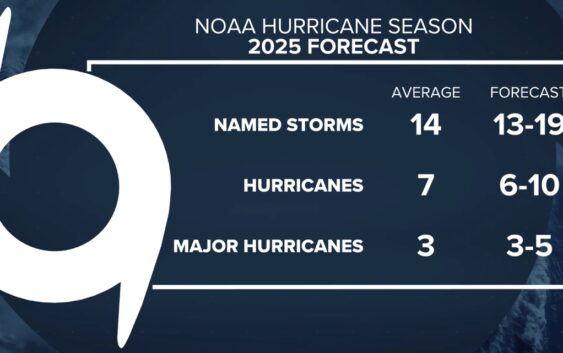- Why no hurricanes made landfall in the US in 2025
- Florence to begin interviewing police chief finalists in January
- A West Texas county wants to better prepare for floods. Paying for it will be tricky.
- They couldn’t save their daughters’ lives in the July 4 floods. Now they’re dealing with the grief and the guilt.
- Austin could see heavy rains, possible flooding over the next few days
NOAA forecasts above-average Atlantic hurricane season

The 2025 hurricane season outlook was released today.
CHARLOTTE, N.C. — The National Oceanic and Atmospheric Administration released its 2025 hurricane season outlook Thursday. As expected, an above-average season is expected.
NOAA’s forecast calls for 13 – 19 named storms, which is categorized as a tropical storm or stronger. Of those, 6 – 10 are expected to become hurricanes. Within those 6 – 10 hurricanes, 3 – 5 will reach major hurricane criteria.
The Atlantic Basin averages are 14 named storms, 7 hurricanes, and 3 major hurricanes.
This is in line with other seasonal outlooks issued by Colorado State University and NC State.
One of the big reasons for this is influence due to La Nina climate conditions. During this cycle, there are normally more storms due to warmer ocean waters, less wind shear, and more atmospheric instability.
So, are we in a La Nina pattern?
Although the seasonal outlook was influenced by La Nina, climate predictions are trending toward a neutral phase for early summer. This neutral phase of the ENSO (El Nino Southern Oscillation) cycle is referred to as La Nada.
During La Nada seasons, there are typically 2 – 3 named storms than average, and some of the strongest hurricanes ever to make landfall in the United States occurred during La Nada years.
Notable hurricane seasons while in a “La Nada” phase
-
2005: The most active season on record, with 28 named storms, occurred during ENSO-neutral conditions before transitioning into a La Niña after Katrina. This season spawned five Category 5 hurricanes. Despite neutral ENSO, exceptionally warm Atlantic waters fueled rapid intensification.
-
1992: Hurricane Andrew, one of the strongest U.S. landfalls, struck during a neutral phase. This season demonstrated that even low storm counts can produce catastrophic events. Proving it only takes just one.
-
2019: Highlighted the unpredictability of neutral phases, as Hurricane Dorian’s extreme intensity contrasted with otherwise moderate seasonal activity. Dorian was also one of the slowest moving storms which at one point was stationary as a Category 5 hurricane.
Contact Brittany Van Voorhees at bvanvoorhe@wcnc.com and follow her on Facebook, X and Instagram.